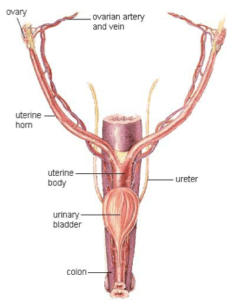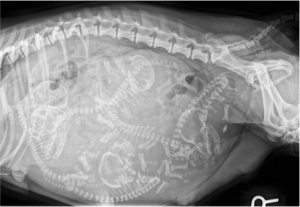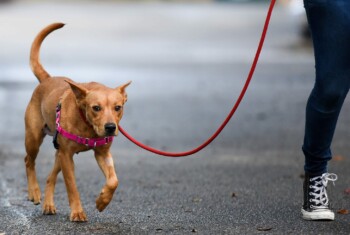Dystocia: Diagnosis and treatment.
Dystocia means difficulty giving birth.
Anatomy.
 In dogs and cats, the uterus consists of two tubes or uterine horns that join with a short uterine body. This is the incubator that nourishes unborn puppies and kittens.
In dogs and cats, the uterus consists of two tubes or uterine horns that join with a short uterine body. This is the incubator that nourishes unborn puppies and kittens.
Signs of a normal delivery (parturition).
Within one to two weeks of delivery of puppies and kittens, the pregnant animal’s mammary glands become enlarged, turgid, and secrete milk. Within 12 to 24 hours of delivery, the mother will become restless; seek seclusion; lose her appetite and create a nest; and her rectal temperature will drop to below 99° Fahrenheit.
Clinical signs of abnormal delivery.
A pregnancy lasting more than 68 days is considered abnormal. Breeds of dogs that commonly experience dystocia include bulldogs, pugs and Boston terriers. In addition, it is more common for a dog to experience dystocia during the first pregnancy. Cats usually do not develop dystocia.
Warning signs that your dog is experiencing dystocia:
- Strong abdominal contractions for greater than 30 minutes with no delivery of a puppy
- Weak straining for greater than two hours with no delivery of a puppy
- Greater than four hours between the delivery of puppies
- A retained pup at the vulva
- Lochia (green/black discharge from vulva) present for three hours with no delivery of a puppy
- Copious clear discharge
- Bloody discharge from the vulva
Diagnosis.
The diagnosis of dystocia is generally based on clinical signs; however, some testing is usually done to ensure that your dog does not have a medical reason for the dystocia. During the evaluation, a complete blood count, calcium blood level, potassium blood level, glucose blood level, and x-rays to check the size and number of puppies may be performed.
Treatment.
Medical treatment of dystocia is generally attempted first unless there is a reason that a C-section should be immediately performed. Reasons for recommending a C-section may include a very large puppy, a malpositioned puppy, abnormal pelvic bone structure that would preclude natural delivery (previous fracture of the pelvis) or complete exhaustion of the mother.
Medicines that are used to help the mother deliver the puppies naturally include oxytocin that stimulates uterine contraction, calcium and intravenous fluids containing electrolytes.
In the event that natural delivery is not possible, a C-section will be performed. With the animal under anesthesia, an incision is made on the abdomen to expose the uterus, and then the puppies are removed from the uterus. To ensure their safe recovery, the puppies are then cared for by an intensive care unit technician.
made on the abdomen to expose the uterus, and then the puppies are removed from the uterus. To ensure their safe recovery, the puppies are then cared for by an intensive care unit technician.
Results.
Early intervention with medical or surgical therapy will allow for the best survival of both the mother and her puppies.
Potential complications that may occur include anesthetic death of mother or puppies, stillborn puppies, infection, subinvolution of the uterus (evidenced by bloody vaginal discharge for weeks after surgery) and toxemia.


